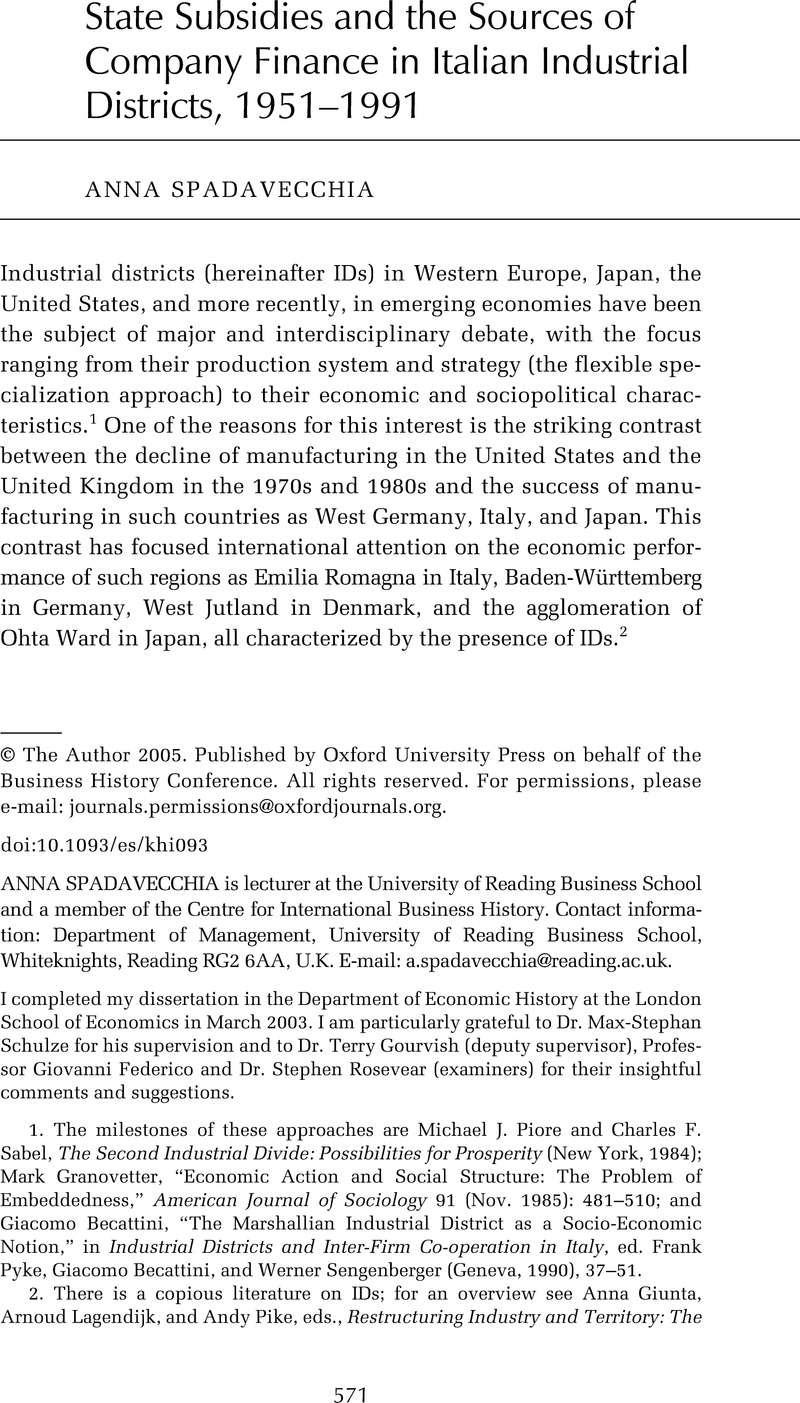No CrossRef data available.
Article contents
State Subsidies and the Sources of Company Finance in Italian Industrial Districts, 1951–1991
Published online by Cambridge University Press: 18 February 2015
Abstract

- Type
- Dissertation Summaries
- Information
- Copyright
- Copyright © The Author(s) 2005. Published by Cambridge University Press on behalf of the Business History Conference. All rights reserved.
References
1. The milestones of these approaches are Piore, Michael J. and Sabel, Charles F., The Second Industrial Divide: Possibilities for Prosperity (New York, 1984)Google Scholar; Granovetter, Mark, “Economic Action and Social Structure: The Problem of Embeddedness,” American Journal of Sociology 91 (Nov. 1985): 481–510Google Scholar; and Becattini, Giacomo, “The Marshallian Industrial District as a Socio-Economic Notion,” in Industrial Districts and Inter-Firm Co-operation in Italy, ed. Pyke, Frank, Becattini, Giacomo, and Sengenberger, Werner (Geneva, 1990), 37–51.Google Scholar
2. There is a copious literature on IDs; for an overview see Giunta, Anna, Lagendijk, Arnoud, and Pike, Andy, eds., Restructuring Industry and Territory: The Experience of Europe‘s Regions (London, 2000)Google Scholar; Odaka, Konosuke and Sawai, Minoru, eds., Small Firms, Large Concerns: The Development of Small Business in Comparative Perspective (New York, 1999)Google Scholar; Pyke, Frank and Sengenberger, Werner, eds., Industrial Districts and Local Economic Regeneration (Geneva, 1992)Google Scholar; Storper, Michael and Scott, Allen J., eds., Pathways to Industrialization and Regional Development (London, 1992)Google Scholar; and Hirst, Paul Q. and Zeitlin, Jonathan, eds., Reversing Industrial Decline: Industrial Structure and Policy in Britain and Her Competitors (Oxford, 1989)Google Scholar.
3. Guerrieri, Paolo and Milana, Carlo, L’Italia e il commercio mondiale (Bologna, 1990), 102–10Google Scholar; Bellandi, Marco and Ottati, Gabi Dei, “Per una ‘rilettura territoriale delle trasformazioni dell’economia italiana’: cronaca di un progetto,” in Il caleidoscopio dello sviluppo locale. Trasformazioni economiche nell’Italia contemporanea, ed. Becattini, Giacomo et al. (Turin, 2001), 29–39.Google Scholar
4. Sabel, Charles F. and Zeitlin, Jonathan, “Historical Alternatives to Mass Production: Politics, Markets and Technology in Nineteenth-Century Industrialization,” Past and Present 108 (Aug. 1985): 133–76CrossRefGoogle Scholar; Piore and Sabel, Second Industrial Divide.
5. Saba, Andrea, Il modello Italiano (Milan, 1995), 132Google Scholar. In other studies the argument of the importance of self-financing is implicit; see, for instance, Fuà, Giorgio and Zacchia, Cesare, eds., Industrializzazione senza fratture (Bologna, 1983)Google Scholar; and Bagnasco, Arnaldo, Tre Italie. La problematica territoriale dello sviluppo italiano (Bologna, 1977)Google Scholar. The possession of land is considered of particular importance in the transformation of the agricultural family into an entrepreneurial unit as the sale of the land provides an initial capital to invest in the family business. See, for instance, Paci, Massimo, La struttura sociale Italiana (Bologna, 1982), 118Google Scholar. Bull and Corner point out a similar dynamic behind the emergence of family business in the second half of the nineteenth century, whereas Colli refers more broadly to family capital. Bull, Anna Cento and Corner, Paul, From Peasant to Entrepreneur (Oxford, U.K., 1993), 144–45Google Scholar; Colli, Andrea, The History of Family Business, 1850–2000 (Cambridge, U.K., 2003)Google Scholar.
6. Conti, Giuseppe and Ferri, Giovanni, “Banche locali e sviluppo economico decentrato,” in Storia del capitalismo italiano dal dopoguerra ad oggi, ed. Barca, Fabrizio (Rome, 1997), 429–65.Google Scholar
7. Enright, Michael J., “Organization and Coordination in Geographically Concentrated Industries,” in Coordination and Information: Historical Perspectives on the Organization of Enterprise, ed. Lamoreaux, Naomi R. and Raff, Daniel M. G. (Chicago, 1995), 103–42.Google Scholar
8. See Marshall, Alfred, Principles of Economics, 2 vols. (9th Variourum ed.; London, 1961), 1: 271Google Scholar; and also Whitaker, John K., ed., The Early Writings of Alfred Marshall, 1967–1890, 2 vols. (London, 1975), 2: 197–98.Google Scholar
9. In 1952 the Bank of Italy defined short-term loans as those repayable within one year and medium-term credit as repayable from one to ten years, except in southern Italy (up to fifteen years). Short-term finance aimed to provide working capital, and medium-term finance provided capital for investment. Pontolillom, Vincenzo “Aspetti del sistema di credito speciale con particolare riferimento all’intervento dello Stato,” in Bollettino, Banca d’Italia (March 1971): 107–28.Google Scholar
10. Menichella, Donato, “Memoria sottoposta dall’IRI all’esame della Corporazione dell previdenza e del credito,” in Donato Menichella. Stabilità e sviluppo dell’economia italiana 1946–1960, ed. Cotula, Franco, Gelsomino, Cosma O., and Gigliobianco, Alfredo, vol. 1: Documenti e discorsi (Rome-Bari, 1997), 128–52.Google Scholar
11. In the 1950s small and medium-sized firms were defined as those employing no more than five hundred workers and having net assets below 1.5 billion lire; for southern firms the upper limit on assets was twice as much, 3 billion lire.
12. Saraceno, Pasquale, “Lo Sviluppo industriale delle regioni meridionali e l’attività della Cassa per il Mezzogiorno,” L’Industria, Rivista di Economia Politica 4 (Oct. 1953): 651–79Google Scholar; Confederazione Generale Italiana del Lavoro (CGIL), La Politica di Sviluppo Economico del Mezzogiorno (Rome, 1970)Google Scholar.
13. Vassalli, Francesco and Vicentini, Gustavo, eds., Legislazione Economica, Settembre 1976–Agosto 1977 (Milan, 1978), 27–30.Google Scholar
14. Gianfranco Viesti, , Come nascono i distretti industriali (Rome-Bari, 2000)Google Scholar.
15. Filippo Siracusano and Carlo Tresoldi, “Le piccole imprese manifatturiere nel Mezzogiorno: diseconomie esterne, incentivi, equilibri gestionali e finanziari,” in Il sistema finanziario nel Mezzogiorno, Banca d’Italia, Numero Speciale dei Contributi all’Analisi Economica (Rome, 1990), 103–43.
16. Bagella, Michele and Caggese, Andrea, “Struttura del capitale, finanziamenti agevolati e redditività delle imprese manifatturiere italiane,” Rassegna Economica 59 (Oct. 1995): 813–37.Google Scholar
17. Calomiris, Charles W. and Himmelberg, Charles P., “Government Credit Policy and Industrial Performance (Japanese Machine Tool Producers, 1963–91),” World Bank, Policy Research Working Paper no. 1434 (Washington, D.C., 1995)Google Scholar.
18. Calomiris, Charles W. and Himmelberg, Charles P., “Directed Credit Programs for Agriculture and Industry: Arguments from Theory and Facts,” in Proceedings of the World Bank Annual Conference on Development Economics, 1993 (Washington, D.C., 1994), 113–37Google Scholar; Calomiris and Himmelberg, “Government Credit Policy and Industrial Performance,” 4.
19. McDonald, M. Closkey, “English Open Fields as a Behaviour towards Risk,’ Research in Economic History 1 (1976): 124–70.Google Scholar
20. Piore, and Sabel, , Second Industrial Divide, 29–30, 227–29.Google Scholar
21. Weiss, Linda, Creating Capitalism: The State and Small Business since 1945 (Oxford, U.K., 1988)Google Scholar.


